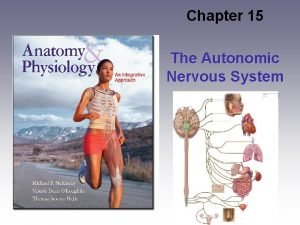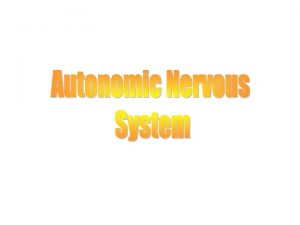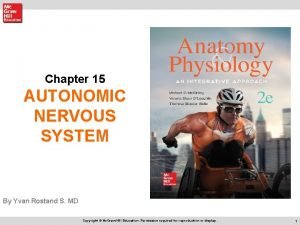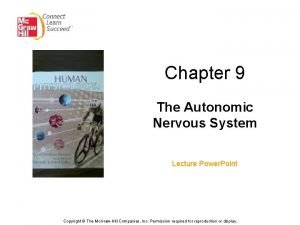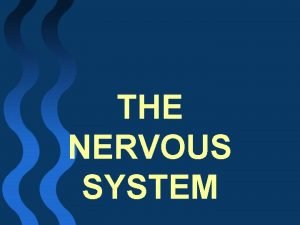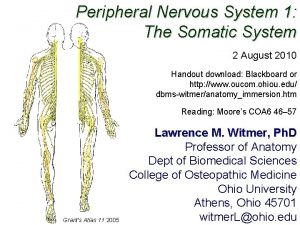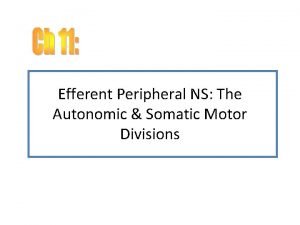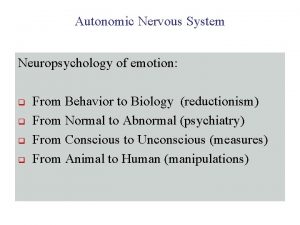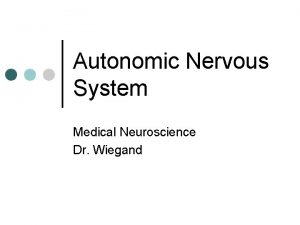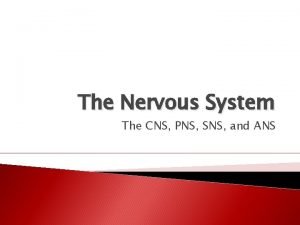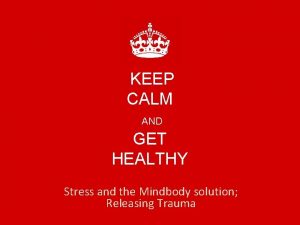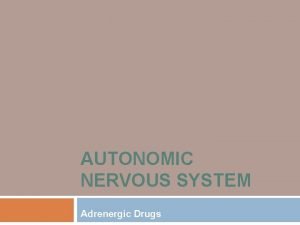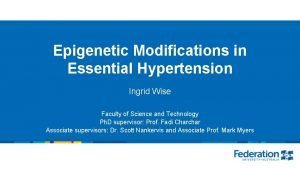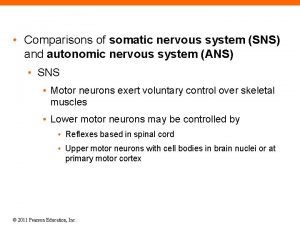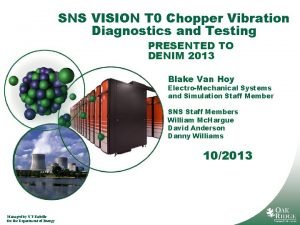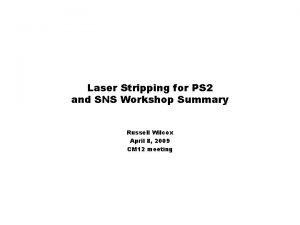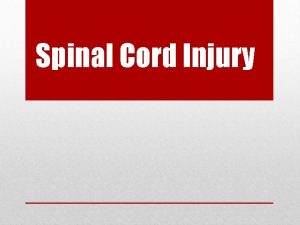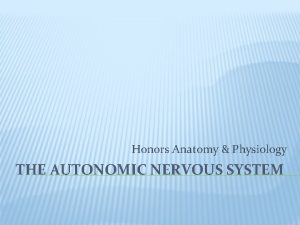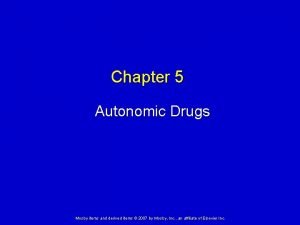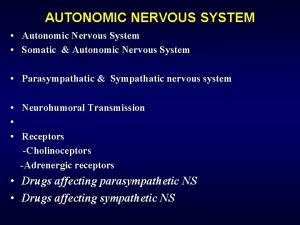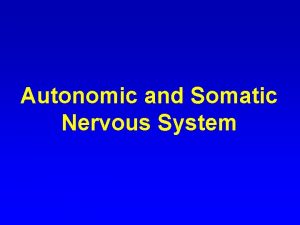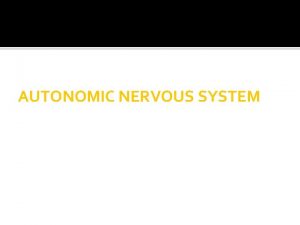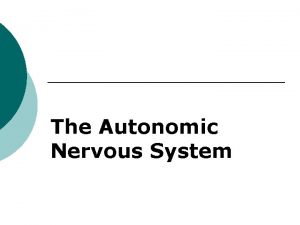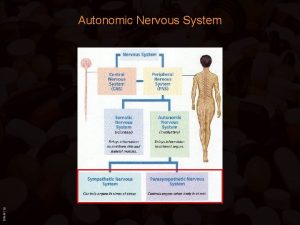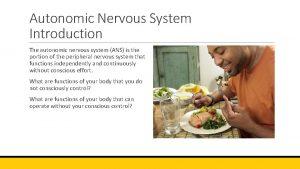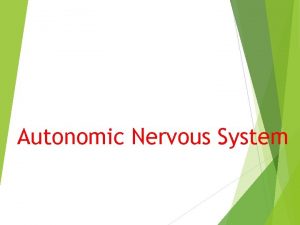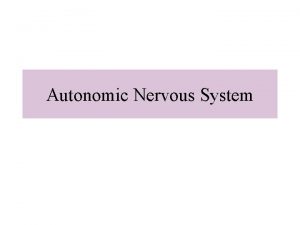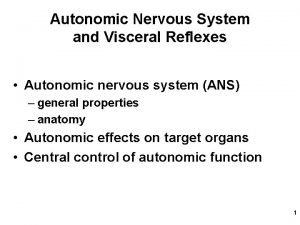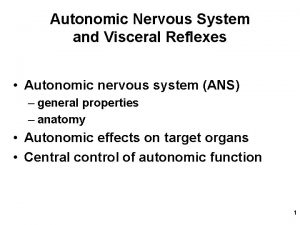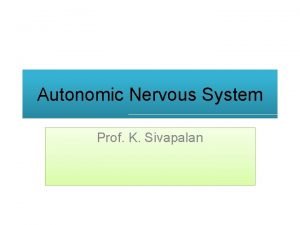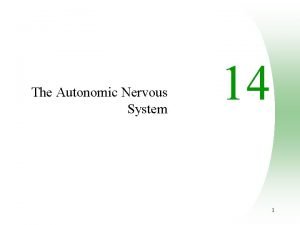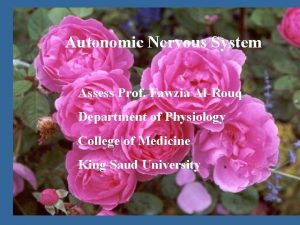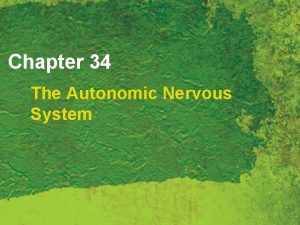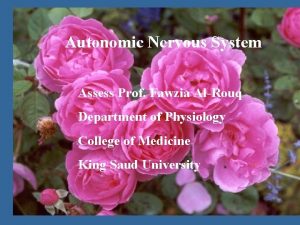Comparisons of somatic nervous system SNS and autonomic













































- Slides: 45

• Comparisons of somatic nervous system (SNS) and autonomic nervous system (ANS) • SNS • Motor neurons exert voluntary control over skeletal muscles • Lower motor neurons may be controlled by • Reflexes based in spinal cord • Upper motor neurons with cell bodies in brain nuclei or at primary motor cortex © 2011 Pearson Education, Inc.

A schematic of the somatic nervous system (SNS), which provides conscious and sub. Conscious control over skeletal muscles Upper motor neurons in primary motor cortex BRAIN Somatic motor nuclei of brain stem Skeletal muscle Lower motor neurons Spinal cord Somatic motor nuclei of spinal cord Skeletal muscle © 2011 Pearson Education, Inc.

Section 1: ANS Functional Anatomy and Organization • Comparisons of somatic nervous system (SNS) and autonomic nervous system (ANS) (continued) • ANS • CNS motor neurons synapse with visceral motor neurons in autonomic ganglia, which control visceral effectors • Integrative centers located in hypothalamus • Two types of visceral motor neurons 1. Preganglionic neurons (cell bodies in CNS) • Activities represent direct reflex responses 2. Ganglionic neurons (cell bodies in autonomic ganglia) • © 2011 Pearson Education, Inc. Innervate effectors like cardiac and smooth muscle

Visceral motor nuclei in hypothalamus BRAIN Preganglionic neuron Visceral Effectors Smooth muscle Glands Cardiac muscle Autonomic ganglia Ganglionic neurons Adipocytes Preganglionic neuron A schematic of the autonomic nervous system (ANS), which controls visceral functions largely outside our awareness © 2011 Pearson Education, Inc. Autonomic nuclei in brain stem Spinal cord Autonomic nuclei in spinal cord

Module 14. 1: ANS divisions • Three ANS divisions 1. Sympathetic (or thoracolumbar) division • Axons emerge from thoracic and superior lumbar segments of spinal cord • • Innervate ganglia relatively close to spinal cord “Kicks in” only during periods of exertion, stress, or emergency 2. Parasympathetic (or craniosacral) division • Axons emerge from brain stem and sacral spinal segments • • Innervate ganglia very close (or within) target organs Most often, effects are opposite to sympathetic © 2011 Pearson Education, Inc.

Autonomic Nervous System Sympathetic Division Parasympathetic Division In the sympathetic division, or thoracolumbar (thor-a-kō-LUM-bar) division, axons emerge from the thoracic and superior lumbar segments of the spinal cord and innervate ganglia relatively close to the spinal cord. In the parasympathetic division, or craniosacral (krā-nē-ō-SĀ-krul) divions, axons emerge from the brain stem and the sacral segments of the spinal cord, and they innervate ganglia very close to (or within) target organs. Cranial nerves (III, VII, IX, and X) The two main divisions of the ANS: the sympathetic and parasympathetic divisions Thoracic nerves Lumbar nerves (L 1, L 2 only) T 1 T 2 T 3 T 4 T 5 T 6 T 7 T 8 T 9 T 10 T 11 T 12 L 1 L 2 S 3 S 4 © 2011 Pearson Education, Inc. Sacral nerves (S 2, S 3, S 4 only)

Module 14. 1: ANS divisions • Three ANS divisions (continued) 3. Enteric nervous system (ENS) • Extensive network of neurons (~100 million) and nerve networks within walls of digestive tract • Influenced by sympathetic and parasympathetic divisions • • However, many complex visceral activities are coordinated on a local level (without CNS instructions) Will be discussed more in Digestive System © 2011 Pearson Education, Inc.

The extensive system of neurons and nerve networks of the enteric nervous system (ENS) Esophagus Stomach Large intestine Small intestine © 2011 Pearson Education, Inc.

Aortic arch Right vagus nerve Trachea Autonomic Plexuses and Ganglia Cardiac plexus Pulmonary plexus Thoracic sympathetic chain ganglia Esophageal plexus Left vagus nerve Thoracic spinal nerves Esophagus Splanchnic nerves Celiac plexus and ganglion Superior mesenteric ganglion Diaphragm Superior mesenteric artery Inferior mesenteric plexus and ganglion Hypogastric plexus Pelvic symapthetic chain Representative plexuses, ganglia, and nerves of the sympathetic and parasympathetic divisions © 2011 Pearson Education, Inc. Inferior mesenteric artery

• Autonomic ganglia • Sympathetic division • Preganglionic fibers (neurons) are relatively short while postganglionic fibers (neurons) are relatively long • • Accordingly, sympathetic ganglia (where these fibers synapse) are relatively near spinal cord Specific ganglia 1. Sympathetic chain (on either side of spinal cord) • Innervates visceral effectors in thoracic cavity, head, body wall, and limbs © 2011 Pearson Education, Inc.

• Sympathetic division (continued) • Specific ganglia (continued) 2. Collateral ganglia (within abdominopelvic cavity) • Includes celiac, superior, and inferior mesenteric ganglia • Innervates visceral effectors in abdominopelvic cavity 3. Adrenal medulla • Center of adrenal gland • Acts as endocrine gland • Targets organs and systems throughout body © 2011 Pearson Education, Inc.

Module 14. 2: Autonomic ganglia • Sympathetic division (continued) • Prepares body for heightened levels of somatic activity • Known as “fight or flight” division • Typical responses 1. Heightened mental alertness 2. Increased metabolic rate 3. Reduced digestive and urinary functions 4. Activation of energy reserves 5. Increased respiratory rate and dilation of passageways 6. Elevated heart rate and blood pressure 7. Activation of sweat glands © 2011 Pearson Education, Inc.

Organization of the sympathetic division of the ANS KEY Preganglionic fibers Postganglionic fibers Ganglionic Neurons Preganglionic Neurons Lateral gray horns of spinal segments T 1 -L 2 Each sympathetic chain consists of a series of interconnected ganglia located on either side of the vertebral column. Hormones released into circulation Target Organs Visceral effectors in thoracic cavity, head, body wall, and limbs The collateral ganglia, located within the abdominopelvic cavity, include the celiac, superior mesenteric, and inferior mesenteric ganglia. The center of each adrenal gland contains a sympathetic ganglion, the adrenal medulla, that acts as an endocrine organ. © 2011 Pearson Education, Inc. Ganglionic neurons in the sympathetic chain and collateral ganglia exert their effects through innervation of peripheral target organs. Visceral effectors in abdominopelvic cavity Ganglionic neurons in the adrenal medullae affect target organs throughout the body through the release of hormones into the general circulation. Organs and systems throughout the body

• Parasympathetic division • Typical preganglionic fiber synapses on 6– 8 ganglionic neurons • May be situated in: • Terminal ganglia (near target organ) • Usually paired • Ciliary ganglion (intrinsic eye muscles) • Pterygopalatine and submandibular ganglia (nasal, tear, and salivary glands) • Otic ganglion (parotid salivary gland) © 2011 Pearson Education, Inc.

• Parasympathetic division (continued) • Typical preganglionic fiber synapses on 6– 8 ganglionic neurons (continued) • May be situated in: (continued) • Intramural (murus, wall) ganglia (embedded in target organ wall) • Typically interconnected masses/clusters of cells • Innervate visceral organs of neck, and of thoracic and abdominopelvic cavities © 2011 Pearson Education, Inc.

Module 14. 2: Autonomic ganglia • Parasympathetic division (continued) • Concerned with regulation of visceral function and energy conservation • Known as “rest and digest” system • Typical responses 1. Decreased metabolic rate 2. Decreased heart rate and blood pressure 3. Increased salivary and digestive gland secretion 4. Increased digestive tract motility and blood flow 5. Stimulation of urination and defecation © 2011 Pearson Education, Inc.

Organization of the parasympathetic division of the ANS KEY Preganglionic fibers Postganglionic fibers Preganglionic Neurons The midbrain, pons, and medulla oblongata contain parasympathetic nuclei associated with cranial nerves III, VII, IX, and X. Ganglionic Neurons III Ciliary ganglion Intrinsic eye muscles (pupil and lens shape) Pterygopalatine and submandibular ganglia Nasal glands, tear glands, and salivary glands Otic ganglion Parotid salivary gland VII IX X Intramural ganglia In sacral segments of the spinal cord, parasympathetic nuclei lie in the lateral gray horns of spinal segments S 2–S 4. © 2011 Pearson Education, Inc. Target Organs Pelvic nerves Intramural ganglia Visceral organs of neck, thoracic cavity, and most of abdominal cavity Visceral organs in inferior portion of abdominopelvic cavity

Module 14. 3: Autonomic innervation patterns • Sympathetic division • Every spinal nerve has a gray ramus carrying sympathetic postganglionic fibers • Preganglionic fibers passing to collateral ganglia form splanchnic nerves • Postganglionic fibers innervating thoracic cavity structures form bundles or sympathetic nerves © 2011 Pearson Education, Inc.

Module 14. 3: Autonomic innervation patterns • Parasympathetic division • Vagus nerve (X) alone provides ~75% of all parasympathetic outflow • • Numerous vagus nerve branches intermingle with sympathetic fibers forming nerve plexuses Preganglionic fibers in sacral spinal cord segments form distinct pelvic nerves • Innervate intramural ganglia in kidneys, bladder, terminal portions of large intestine, and sex organs © 2011 Pearson Education, Inc.

The innervation of the parasympathetic division on one side of the body; the innervation on the opposite side (not shown) follows the same pattern KEY Preganglionic neurons Ganglionic neurons Pterygopalatine ganglion Lacrimal gland Eye Ciliary ganglion PONS VII IX III Submandibular ganglion Salivary glands Otic ganglion Vagus nerve (X), which provides about 75 percent of all parasympathetic outflow Heart Cardiac plexus Lungs Celiac plexus Spinal cord Liver and gallbladder Stomach Spleen Inferior mesenteric plexus Pancreas Hypogastric plexus Preganglionic fibers in the sacral segments of the spinal cord, which carry sacral parasympathetic output Large intestine Small intestine Rectum S 2 S 3 Kidney S 4 Penis Uterus © 2011 Pearson Education, Inc. Ovary Scrotum Urinary bladder

Module 14. 4: Autonomic neurotransmitters and receptors • Sympathetic division • Adrenergic receptors (bind “adrenaline”) • Located in plasma membranes of target cells • Binding of epinephrine (E) or norepinephrine (NE) activates enzymes (2 nd messenger system) within cell • Two classes 1. Alpha receptors (generally stimulated by NE & E) • α 1 receptors – generally excitatory • α 2 receptors – generally inhibitory © 2011 Pearson Education, Inc.

Module 14. 4: Autonomic neurotransmitters and receptors • Sympathetic division (continued) • Adrenergic receptors (continued) • Two classes (continued) 2. Beta receptors (generally stimulated by E) • β 1 receptors – cardiac muscle stimulation and increased tissue metabolism • β 2 receptors – relaxation of respiratory passage and blood vessel smooth muscle • β 3 receptors – release of fatty acids from adipose tissue for metabolic use in other tissues © 2011 Pearson Education, Inc.

Module 14. 4: Autonomic neurotransmitters and receptors • Sympathetic division (continued) • Neurotransmitter release • Epinephrine (E) and norepinephrine (NE) can be released • Locally, involving more norepinephrine • • Effects last a few seconds Generally, from adrenal medulla • 3× more epinephrine than norepinephrine • More beta receptors activated • Effects may last several minutes © 2011 Pearson Education, Inc.

The effects of sympathetic stimulation, which result primarily from the interactions of NE and E with adrenergic receptors in the target cell’s plasma membrane The stimulation of alpha receptors by norepinephrine, which activates enzymes on the inside of the target cell’s plasma membrane The stimulation of beta receptors by epinephrine, which triggers changes in the metabolic activity of the target cell Epinephrine Norepinephrine Plasma membrane Alpha receptor Beta receptor If α 2 receptor If α 1 receptor Second messengers activated Activation of adenylate cyclase Reduction of c. AMP levels c. AMP Release of Ca 2+ from ER Smooth muscle contraction Gland cell secretion CYTOPLASM OF TARGET CELL © 2011 Pearson Education, Inc. Inhibition of cell If β 1 receptor Cardiac muscle stimulation and increased tissue metabolism ATP If β 2 receptor Relaxation of smooth muscle in respiratory passages and in the blood vessels of skeletal muscle CYTOPLASM OF TARGET CELL If β 3 receptor Release of fatty acids by adipose tissue for metabolic use in other tissues

Module 14. 4: Autonomic neurotransmitters and receptors • Parasympathetic division • Receptors (all bind ACh) 1. Nicotinic receptors (also bind nicotine) • Located on ganglion cell surfaces • • Also on sympathetic ganglion cells and at SNS neuromuscular junctions Always excitatory 2. Muscarinic receptors (also bind muscarine toxin) • Located at cholinergic neuromuscular and neuroglandular junctions as well as some sympathetic cholinergic junctions • Can be excitatory or inhibitory © 2011 Pearson Education, Inc.

Module 14. 5: Anatomical and physiological characteristics of ANS divisions • Characteristics of ANS divisions • Sympathetic activation • Can occur at: • Local level using mainly NE • • Affect only target organs Generalized body using E and NE • Have effects in many organs • Also alters CNS activity • © 2011 Pearson Education, Inc. Controlled by hypothalamus

Module 14. 5: Anatomical and physiological characteristics of ANS divisions • Sympathetic activation effects • Increased alertness through reticular activating system • Feeling of energy and euphoria • Increased activity in cardiovascular and respiratory centers of pons and medulla oblongata • Increased blood pressure, heart/breathing rate, inspiration depth • General elevation in muscle tone • Mobilization of energy reserves • Breakdown of liver and muscle glycogen • Release of adipose tissue lipids © 2011 Pearson Education, Inc.

Module 14. 5: Anatomical and physiological characteristics of ANS divisions • Parasympathetic activation • Under normal conditions, not controlled or activated as a whole • Active continuously as individual reflex responses • Effects center on relaxation, food processing, and energy absorption • Also called anabolic division (anabole, a rising up) because blood nutrients generally increase © 2011 Pearson Education, Inc.

Module 14. 5: Anatomical and physiological characteristics of ANS divisions • Parasympathetic activation effects • Constrictions of pupils and focusing of eye lenses for nearby objects • Secretion of digestive glands • Secretion of hormones that promote nutrient absorption and utilization • Blood flow and glandular activity changes associated with sexual arousal © 2011 Pearson Education, Inc.

Module 14. 5: Anatomical and physiological characteristics of ANS divisions • Parasympathetic activation effects (continued) • Increased digestive organ smooth muscle activity • Stimulation and coordination of defecation • Contraction of urinary bladder during urination • Constriction of respiratory passageways • Reduction in heart rate and force of contraction © 2011 Pearson Education, Inc.

Section 2: Autonomic Regulation and Control Mechanisms • ANS output affects virtually every body system • Unconscious ANS control can maintain homeostasis and vital physiological processes without conscious input • Survival in a coma can continue for decades © 2011 Pearson Education, Inc.

A general overview of the way the nervous system distributes information and issues motor commands Central nervous system (CNS) processing Sensory processing centers Processing at the conscious level, which can be affected by memory, learning, or planning. Motor centers operating at the subconscious level. Motor Responses Motor pathways Somatic Visceral Sensory pathways Stimulus © 2011 Pearson Education, Inc. General sensory receptors Somatic nervous system (SNS) Autonomic nervous system (ANS) Somatic effectors (skeletal muscles) Visceral effectors (smooth muscle, glands, cardiac muscle, adipocytes) Figure 14 Section 2

Module 14. 6: Visceral responses to ANS control • Even in the absence of stimuli, autonomic motor neurons maintain continuous activity • = Autonomic tone • Many organs receive signals from both ANS divisions • = Dual innervation • Effects may be opposing or complementary • In organs with only sympathetic innervation, response may vary with receptor type © 2011 Pearson Education, Inc.

Module 14. 6: Visceral responses to ANS control • Dual innervation example: heart • Heart consists of cardiac muscle tissue triggered by specialized pacemaker cells affected by ANS • Parasympathetic: ACh release decreases heart rate • Sympathetic: NE release accelerates heart rate • Small amounts of both neurotransmitters released continuously to maintain autonomic tone • Under resting conditions, parasympathetic dominates © 2011 Pearson Education, Inc.

At rest, both ANS divisions are active at low levels, but parasympathetic effects predominate. Increased parasympathetic stimulation lowers the heart rate. Parasympathetic inhibition or sympathetic stimulation increases the heart rate. The balance between these factors can be precisely adjusted. Increased sympathetic stimulation combined with parasympathetic inhibition result in an increase in heart rate to maximum levels. Heart rate (beats per minute) 180 120 72 50 Time The effects of both autonomic divisions on the heart, which receives dual innervation 2 © 2011 Pearson Education, Inc.

Module 14. 7: Visceral reflexes • Provide automatic motor responses that can be modified, facilitated, or inhibited by higher centers (especially those of hypothalamus) • All are polysynaptic • Components of reflex arc 1. Receptor (interoceptors such as nociceptors, thermoreceptors, baroreceptors, chemoreceptors, etc. ) 2. Sensory neuron 3. Processing center (spinal cord nuclei and solitary nuclei of brain stem) 4. Visceral motor neurons (one or two) © 2011 Pearson Education, Inc.

Module 14. 7: Visceral reflexes • Two visceral reflex types 1. Short reflexes • Bypass CNS entirely • • Control simple motor responses with localized effects • • Impulses relay with interneurons in ganglia Usually just one part of an organ Predominate in enteric nervous system © 2011 Pearson Education, Inc.

A short reflex, which bypasses the CNS and involves sensory neurons and interneurons whose cell bodies are located within autonomic ganglia Stimulus Receptors in peripheral tissue Afferent (sensory) fibers Short reflex Autonomic ganglion Peripheral Response effector Ganglionic neuron 1 © 2011 Pearson Education, Inc.

Module 14. 7: Visceral reflexes • Two visceral reflex types (continued) 2. Long reflexes • Pathway • Visceral sensory neurons in cranial nerves and autonomic nerves enter CNS through dorsal roots • Interneurons process information in CNS • ANS motor neurons carry response to visceral effectors • Predominate over short reflexes • Activate entire organs and coordinate responses of multiple organ systems © 2011 Pearson Education, Inc.

A long reflex, which is the autonomic equivalent of a polysynaptic reflex Central nervous system Stimulus Receptors in peripheral tissue Long reflex Response Processing center in spinal cord (or brain) Peripheral effector Preganglionic neuron Autonomic ganglion © 2011 Pearson Education, Inc.

The sites and functions of the body’s baroreceptors Baroreceptors of Carotid Sinus and Aortic Sinus Provide information on blood pressure to cardiovascular and respiratory control centers Baroreceptors of Lungs Baroreceptors of Digestive Tract Provide information on volume of tract segments, trigger reflex movement of materials along tract Baroreceptors of Bladder Wall Provide information on volume of urinary bladder, trigger urination reflex Provide information on lung stretching to respiratory rhythmicity centers for control of respiratory rate Baroreceptors of Colon Provide information on volume of fecal material in colon, trigger defecation reflex 1 © 2011 Pearson Education, Inc.

The body’s chemoreceptors, which play important roles in the reflexive control of respiration and cardiovascular function Chemoreceptors in Respiratory Centers in the Medulla Oblongata Trigger reflexive adjustments in depth and rate of respiration Respond to the concentrations of hydrogen ions (p. H) and carbon dioxide (PCO 2) in cerebrospinal fluid Chemoreceptors of Carotid Bodies Via cranial Sensitive to changes in the p. H, PCO 2 , and PO 2 in arterial blood Chemoreceptors of Aortic Bodies Sensitive to changes in the p. H, PCO 2, and PO 2 in arterial blood © 2011 Pearson Education, Inc. nerve IX Via cranial nerve X Trigger reflexive adjustments in respiratory and cardiovascular activity

The body’s chemoreceptors, which play important roles in the reflexive control of respiration and cardiovascular function A photomicrograph of a carotid body Chemoreceptive neurons Blood vessel Carotid body © 2011 Pearson Education, Inc. LM x 400 2

Module 14. 9: Levels of ANS motor control • Autonomic activities are controlled mainly in two CNS areas 1. Autonomic ganglia and spinal cord • Simple reflexes 2. Medulla oblongata • More complex reflexes • Cardiovascular reflexes • Respiratory reflexes • Salivation • Swallowing digestive secretions • Peristalsis • Urinary function © 2011 Pearson Education, Inc.

Module 14. 9: Levels of ANS motor control • Lower CNS centers are subject to regulation by higher brain areas • Hypothalamus • Limbic system • Thalamus • Cerebral cortex © 2011 Pearson Education, Inc.
 Somatic nervous system (sns)
Somatic nervous system (sns) Major division of the nervous system
Major division of the nervous system Ans
Ans Autonomic nervous system skeletal muscle
Autonomic nervous system skeletal muscle Sympathetic tone definition
Sympathetic tone definition Autonomic nervous system consists of
Autonomic nervous system consists of Spinal cord dorsal and ventral roots
Spinal cord dorsal and ventral roots Autonomic nervous system
Autonomic nervous system The autonomic nervous system controls
The autonomic nervous system controls Autonomic nervous system visceral
Autonomic nervous system visceral Autonomic nervous system
Autonomic nervous system Terminal ganglia
Terminal ganglia Somatic nervous system
Somatic nervous system Preganglionic parasympathetic fibres
Preganglionic parasympathetic fibres 31 pairs of spinal nerves
31 pairs of spinal nerves Somatic nervous system
Somatic nervous system Dermatome map
Dermatome map Somatic motor division
Somatic motor division Fundamentals of the nervous system and nervous tissue
Fundamentals of the nervous system and nervous tissue Nervous
Nervous Neuronal processes
Neuronal processes Autonomic nerveous system
Autonomic nerveous system Psns and sns
Psns and sns Gallbladdert
Gallbladdert Dermatome map
Dermatome map Limbic system and trauma
Limbic system and trauma Nervous system and digestive system
Nervous system and digestive system Endocrine system and nervous system
Endocrine system and nervous system Endocrine system and nervous system
Endocrine system and nervous system Sns neurotransmitters
Sns neurotransmitters Sns. gov. pt
Sns. gov. pt Bokeh python
Bokeh python Aws dms icon
Aws dms icon Sns
Sns Sns
Sns Pdr kurs
Pdr kurs Sns vision
Sns vision Scottish neighbourhood statistics
Scottish neighbourhood statistics Sns workshop
Sns workshop Ias sns
Ias sns Mechanism of hormone action
Mechanism of hormone action Choque medular
Choque medular Ans
Ans Autonomic network management
Autonomic network management An architectural blueprint for autonomic computing
An architectural blueprint for autonomic computing Mosby items and derived items
Mosby items and derived items







